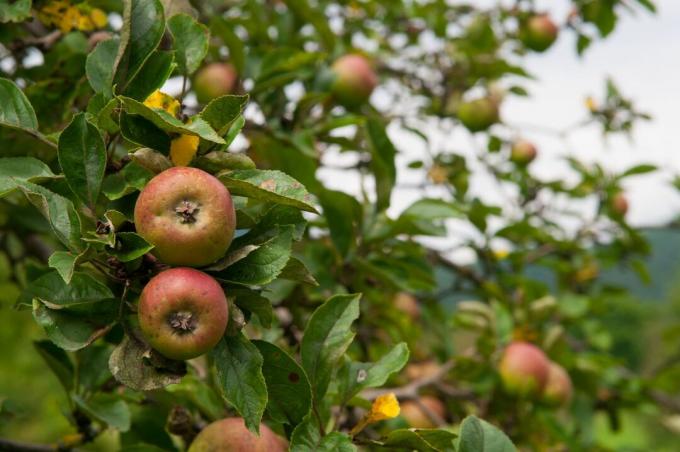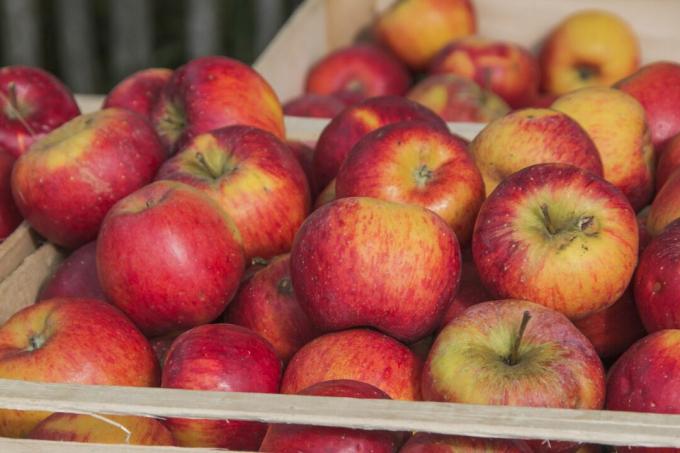'Krügers Dickstiel', also known as 'Celler Dickstiel', is the name of a popular German apple variety that is characterized by its good aroma. We present the winter apple and the special features of cultivation and care.

Hardly any other variety is known by as many synonyms as 'Krügers Dickstiel': Whether as 'Celler Dickstiel', ‘Colour box’ or ‘Dickstiel’ for short – the old apple variety has one in almost every region in northern Germany other names. The diverse naming can also be attributed to the popularity of the 'Krügers Dickstiel' apple variety, which is still appreciated by many enthusiasts today.
contents
- ‘Krügers Dickstiel’: Wanted poster
- history and origin
- Properties and taste of the Celler thick-stalk apple
- Tips on growing and caring for 'Krüger's Dickstiel'
- Harvest and use the 'Krügers Dickstiel' apple variety
‘Krügers Dickstiel’: Wanted poster
| synonyms | 'Celler thick stem', 'color box', 'thick stem' |
| fruit | medium-sized; green-yellow to silver-grey basic color with orange and red marbling (sunny side) and yellow spots (shady side) |
| the taste | slightly sour, spicy-floral aroma |
| yield | high and regular |
| harvest time | early to mid-October |
| maturity | since December |
| shelf life | very good; can be stored until the end of February |
| growth | medium to strong |
| climate | undemanding; Insider tip for locations endangered by late frost |
| diseases and pests | increased susceptibility to powdery mildew in warm areas |
history and origin
The origin of the 'Krügers Dickstiel' apple variety has not been fully clarified. It is known that the variety originated in northern Germany around 1850. Most likely, the variety was first grown in Mecklenburg or in the Celle region. The latter would also provide an explanation for the synonym 'Celler Dickstiel'. After the discovery, the variety quickly spread in northern Germany, at least since the 20th century. In the 19th century, however, the popularity of the variety grew throughout Germany. Conventionally, 'Krügers Dickstiel' is hardly grown today. But it is still one of the most popular apple trees for the garden and is highly valued by many hobby gardeners.
Properties and taste of the Celler thick-stalk apple
The apples of the 'Krügers Dickstiel' variety are medium-sized and evenly round in shape. Above all, their special coloring is characteristic: the green-yellow to silver-grey basic color has orange and red marbling on the sunny side, yellow spots are often found on the shaded side. In addition, the shell is lightly rusted over the entire surface. This unique play of colors also earned the apple the name 'color box'. The flesh inside is firm and white. However, the 'Celler Dickstiel' only becomes a favorite of many apple lovers because of its special aroma: the slightly sour one Apple impresses with a spicy-flowery fruit aroma, which is why it is often one of the best-tasting apple varieties will.
Tips on growing and caring for 'Krüger's Dickstiel'
With its undemanding nature, 'Krüger's Dickstiel' is ideal for growing in the garden. It is considered to be extremely robust and resistant, especially on lighter soils. 'Krüger's Dickstiel' hardly likes to grow only on soils that are particularly rich in clay. You should therefore always pay attention to a light substrate. Especially in locations endangered by late frost, the 'Celler Dickstiel' is a real insider tip.
Due to its very late flowering, it also promises a safe and constant harvest over many years. However, its late flowering also poses a challenge for gardeners: 'Krügers Dickstiel' is one of the poorer pollinators, because it flowers too late for many other apple varieties. At the same time, 'Krügers Dickstiel' also bears fruit poorly if there is no suitable pollinator, such as 'Privy Councilor Dr. Oldenburg', growing nearby.

Even if the 'Celler Dickstiel' grows quickly after planting, the tree shows slow but steady growth overall. With its wide, pyramid-shaped crown, which becomes denser with age, the 'Celler Dickstiel' is also visually very attractive. Depending on the rootstock, 'Krügers Dickstiel' shows moderate to good growth. With weak-growing rootstocks, the variety is easy to train and shows a nice upright growth. If the rootstock is vigorous, pruning 'Krügers Dickstiel' is a bit more complex, because it is very vigorous.
Overall, 'Krügers Dickstiel' is considered to be particularly robust. This also has to do with its low susceptibility to disease: the 'Celler Dickstiel' variety is generally not very susceptible to both scab and specks. 'Krüger's Dickstiel' only shows a certain susceptibility to powdery mildew. Especially in warm locations, he tends to be more susceptible to mildew, which is why he should be examined here more often for the first signs of the disease.
Harvest and use the 'Krügers Dickstiel' apple variety
From early to mid-October, the 'Krügers Dickstiel' apples are ready to be picked, and from December they are ready to eat. Due to their fine, tangy aroma, the fruit is primarily considered a particularly delicate table apple. Its long shelf life makes the 'Krügers Dickstiel' apple variety particularly valuable - if you store the apple correctly, it will keep until the end of February without any problems. To ensure that 'Krügers Dickstiel' does not wilt during storage, special emphasis should be placed on high humidity and low temperatures during storage. In addition to its use as a dessert apple, 'Krügers Dickstiel' is also versatile in the kitchen and is particularly popular for baking because of its firm flesh.
The 'Celler Dickstiel' as a tasty and healthy variety is an asset for the garden, but much too valuable to process! The wealthy ‘mew apple' which, with a bountiful yield, is a perfect apple for processing.
